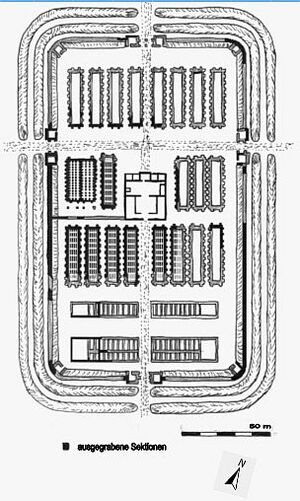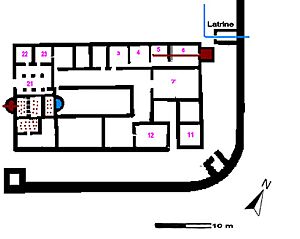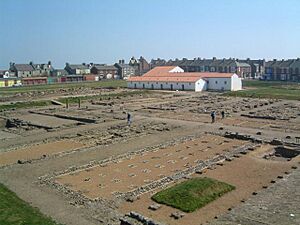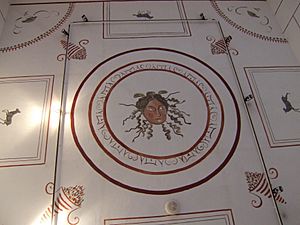Arbeia facts for kids
Quick facts for kids Arbeia Roman Fort and Museum |
|
|---|---|
| Tyne and Wear, England, UK | |
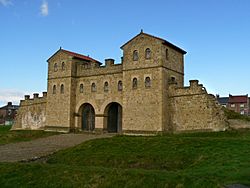
Reconstructed gateway
|
|
|
Location in Tyne and Wear
|
|
| Coordinates | 55°00′14″N 1°25′48″W / 55.004°N 1.430°W |
| Grid reference | NZ365679 |
Arbeia was a large Roman fort located in South Shields, Tyne & Wear, England. Today, it is mostly ruins, but some parts have been rebuilt so visitors can see what it once looked like. People first started digging up the site in the 1870s to learn about its past. All modern buildings on the site were removed in the 1970s. Now, it is managed by North East Museums and is known as Arbeia, South Shields Roman Fort.
Contents
What's in a Name?
The name Arbeia comes from an old Roman document called the Notitia Dignitatum. This document is the only ancient source that mentions the name. For a long time, people weren't sure if Arbeia was the correct name for the fort in South Shields.
However, in 1953, a researcher named Ian Richmond found strong evidence. His work helped confirm that Arbeia was indeed the likely name for the South Shields fort. The name Arbeia might mean "the fort of the Arab troops." This makes sense because, at one point, a group of boatmen from Mesopotamia (modern-day Iraq) were stationed there. These boatmen were from the Tigris River.
A Look at Arbeia's History
Building the Fort
Arbeia Fort was built in 129 AD. This was a few years after most of the other forts along Hadrian's Wall. It was placed on a high spot called the Lawe Top. From here, it could watch over the mouth of the River Tyne. The fort was about four miles past the eastern end of Hadrian's Wall. Its main job was to protect the side of the wall and the important sea route that brought supplies to the wall and a small port nearby.
Changes Over Time
The number of soldiers at Arbeia was reduced when the Romans moved into Scotland during the time of Emperor Antoninus Pius. Later, when Marcus Aurelius was emperor (161 to 180 AD), the fort was used again. Around 198 AD, the fort was changed a lot. A wall was built to divide the fort into two halves. The northern part was used to store supplies from ships. The southern part remained for the soldiers. These changes likely happened because Emperor Septimius Severus was planning to invade Caledonia (modern-day Scotland). Arbeia might have even been his main base for these campaigns.
A Major Supply Base
Between 220 and 235 AD, new buildings were added to the southern part of the fort. This included a new principia (headquarters) and new barracks for soldiers. A larger group of soldiers, called the Cohors V Gallorum, probably lived here. The old headquarters building was turned into a granary, which is a place to store grain. Nine more granaries were built, bringing the total to 24. Most Roman forts only had two granaries. Having 24 showed that Arbeia was a huge supply base. It provided food and other goods for all of Hadrian's Wall, not just its own soldiers.
Later Years and Discovery
In the late 3rd century, people who lived in the nearby village, called a vicus, started moving into the fort. This happened when parts of the fort became empty. After a fire around 300 AD, eight of the granaries were changed into barracks. The headquarters building was made even bigger. A new, very large praetorium (the commanding officer's house) was also built. The fort was finally left empty around 400 AD.
It is believed that King Oswin of Northumbria was born at this fort.
In 1875, the fort was unexpectedly discovered by an amateur. This discovery made national news. Many amazing Roman items were found near the center of a busy industrial town. Archaeologists were surprised by the quality of these finds. At first, some people thought the treasures were fake. But more digging proved that it was a truly exciting archaeological discovery.
Who Lived at Arbeia?
Different groups of Roman soldiers were stationed at Arbeia over the years.
- The first group was the Ala Primae Pannoniorum Sabiniana. This was a cavalry (horseback) regiment of about 500 soldiers from Pannonia (modern-day Hungary).
- Later, another cavalry group, the Ala I Hispanorum Asturum, took their place. These soldiers were from the Astures tribe in north-western Spain.
- Before 222 AD, they were replaced by the Cohors V Gallorum. This was a large infantry (foot soldier) regiment of about 1,000 men. They might have come from Fort Cramond in Scotland.
- The last group of soldiers at Arbeia was the Numerus Barcariorum Tigrisiensium. These were barge-men from the Tigris River in the Middle East. They had been moved from another Roman fort in Lancaster.
The Commanding Officer's House
The praetorium, or commanding officer's house, built after 300 AD, was very fancy. It looked like the elegant homes found in the Mediterranean area during the 3rd and 4th centuries. It had an atrium (a large open entrance hall) that led to a courtyard with columns and a fountain. Most of the rooms were built around this courtyard. Many rooms had beautiful wall paintings. The house even had its own private heated baths, with underfloor heating systems called hypocausts.
The Arbeia Museum
The museum at Arbeia has many interesting items that tell stories about the people who lived there. These items show how diverse the fort's population was.
- One important monument is for a British woman named Regina. She was from the Catuvellauni tribe. Regina was first a slave, then a freedwoman, and finally the wife of Barates. Barates was an Arab merchant from Palmyra (now in Syria). Regina died at age 30, and Barates, who missed her very much, set up her gravestone. Barates himself is buried at a nearby fort called Corbridge.
- Another monument remembers Victor, who was also a former slave. He was freed by Numerianus, a soldier from the Ala I Asturum. Numerianus arranged Victor's funeral with great care when Victor died at age 20. The stone says that Victor was "of the Moorish nation."
The museum also has an altarpiece dedicated to a god that was previously unknown. There is also a stone tablet where the name of Emperor Severus Alexander (who died in 235 AD) was chiseled off. This is an example of damnatio memoriae, which means "condemnation of memory." It was a Roman practice to erase someone's memory after they died, often if they were disliked or disgraced.
Rebuilding the Past
The West Gate of the fort was rebuilt in 1986. This was done to help visitors imagine what the fort looked like in Roman times. The reconstruction was based on careful research from the archaeological digs. The rebuilt parts stand exactly where the original Roman structures once stood.
A Roman gatehouse, barracks (soldiers' living quarters), and the Commanding Officer's house have all been rebuilt on their original foundations. The gatehouse now has many displays about the fort's history. From its upper levels, you can get a great view of the entire archaeological site.
See also
 In Spanish: Arbeia para niños
In Spanish: Arbeia para niños



